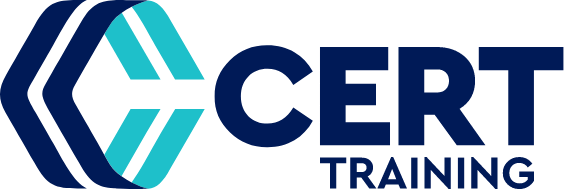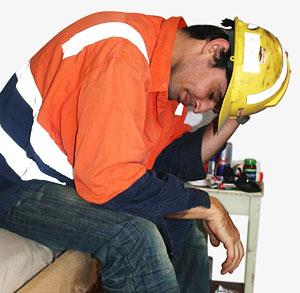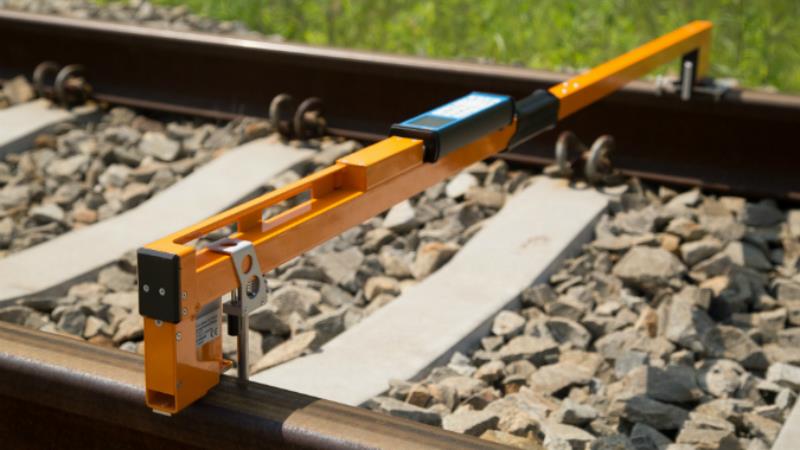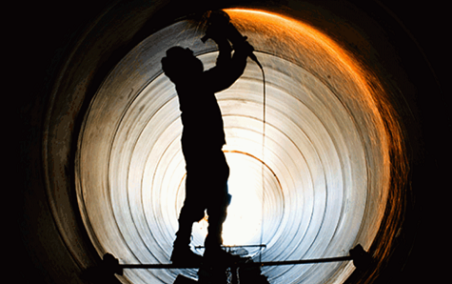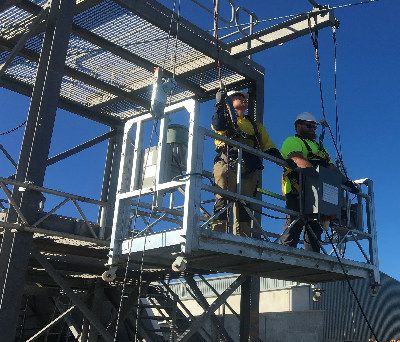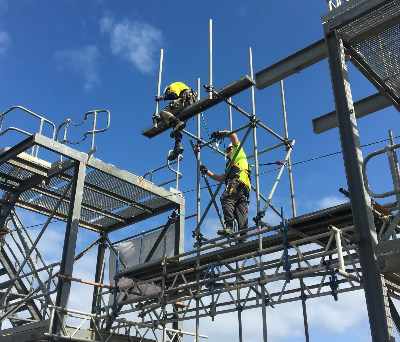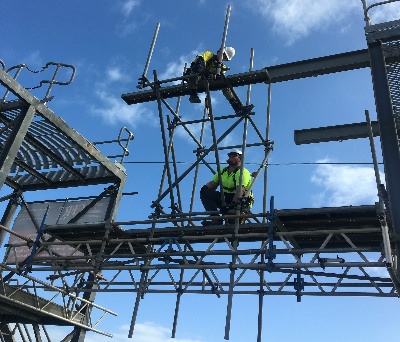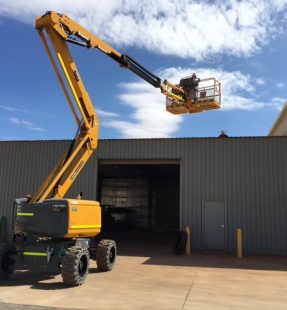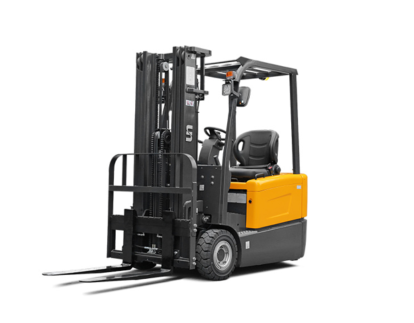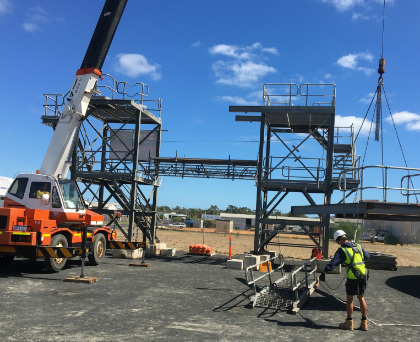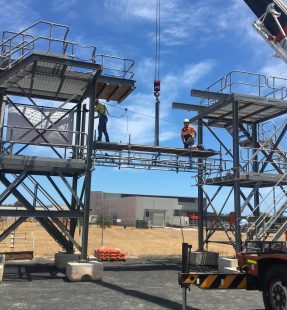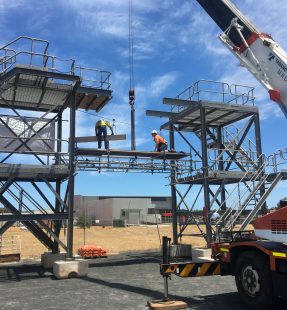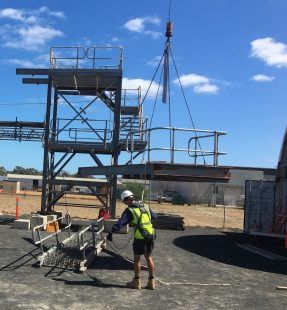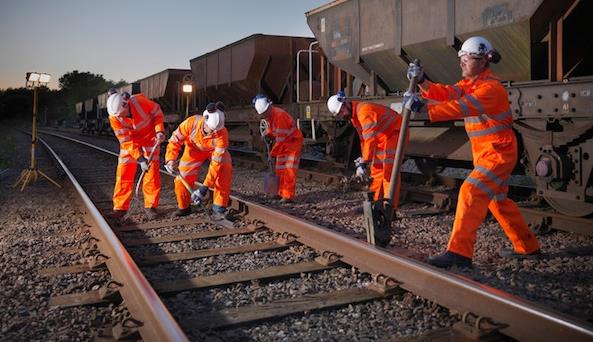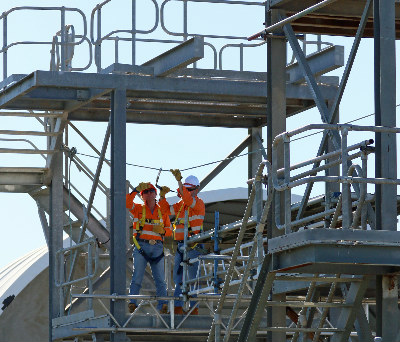Course List
See the list of courses below

** ZOOM ** QR3.2 Safely Access the Rail Corridor (SARC) & TLIF0020
Find Out MoreQLD_SARCZM_0020
This course has been designed for workers who are required to access the rail corridor as part of their role. It is designed to give learners the skills and knowledge required to safely enter and navigate around the rail corridor and danger zone with the permission of the access provider‚ in accordance with legislative and regulatory requirements.
It includes following the policies‚ procedures and protocols of the access provider for situational awareness and rail safety‚ It involves accessing and interpreting information about track protection requirements‚ carrying out assigned protection and/or work activities, and responding appropriately to safety incidents and abnormal situations within the limits of personal responsibility.
**This course is valid for personnel looking to work on the Queensland Rail Network.
QR3.2 SARC course duration is up to 8 hours.
**You must have an RIW number prior to attending the class. To create an RIW number, please click here.
TLIF2010 - Apply Fatigue Management Strategies is delivered as a stand along course to QR3.2. Please refer to our website for available course dates or contact our office **
This workshop is completed online via a zoom session. Requirements for successfully attending this workshop are as follows:
- Individual laptop or desktop computer with a webcam
- Reliable internet connection
- Google Chrome
- Basic computer literacy
- Email address
Adelaide Metropolitan Passenger Rail Network (AMPRN) Induction
Find Out MoreSA_AMPRN
The Safely Access The Rail Corridor (SARC) - Metro course outlines the key hazards of operating in the rail environment and, gives learners the skills and knowledge to safely enter and navigate around the rail corridor.
This version of the course is contextualised for light and heavy rail, train and tram, and involves electrical awareness for people wanting to work on or around these networks.
This course is suitable for individuals with no prior rail industry experience.
Apply Fatigue Management Strategies
Find Out MoreSA_TLIF2010
It includes identifying and acting on signs of fatigue and implementing appropriate strategies to minimise fatigue during work activities‚ in particular when operating equipment, trains, vehicles, load shifting equipment, etc
** You may also require the course QR3.2 - Safely Access the Rail Corridor to work within the Queensland Rail Network. Please refer to our website for available course dates or contact our office **
Apply safety critical communications in the rail environment
Find Out MoreNSW_TLIF0008
This course will revise, refresh and reset your existing skills in communication and practice applying effective safety critical communications behaviours to the rail industry.
Apply Track Fundamentals
Find Out MoreNSW_TLIB2085
This course involves understanding the fundamentals of track maintenance and construction and carrying out basic track measurements in accordance with approved standards‚ safeworking and regulatory requirements and workplace procedures. It includes identifying track terminology, track components and track tools and equipment, and undertaking basic track measurement.
While the unit of competency provided in this course is nationally recognised, additional network-specific training or induction may be required before you are able to work on some networks.
Apply Track Fundamentals
Find Out MoreVIC_TLIB2085
This course involves understanding the fundamentals of track maintenance and construction and carrying out basic track measurements in accordance with approved standards, safeworking and regulatory requirements and workplace procedures. It includes identifying track terminology, track components and track tools and equipment, and undertaking basic track measurement.
While the unit of competency provided in this course is nationally recognised, additional network-specific training or induction may be required before you are able to work on some networks.
Apply Track Fundamentals
Find Out MoreNAT_TLIB2085
This course involves understanding the fundamentals of track maintenance and construction and carrying out basic track measurements in accordance with approved standards‚ safeworking and regulatory requirements and workplace procedures. It includes identifying track terminology, track components and track tools and equipment, and undertaking basic track measurement.
While the unit of competency provided in this course is nationally recognised, additional network-specific training or induction may be required before you are able to work on some networks.
Category 1 Rail Medical_Chullora
Find Out MoreMED_CAT1_NSW_CH
This is the highest level of rail medical available and is for rail workers or contractors undertaking a safety critical role requiring a high level of attentiveness to their tasks and where sudden incapacity may result in a serious incident affecting the public or the rail network.
According to the National Standard for Health Assessment of Rail Safety Workers, a serious incident means: an accident or incident that affects the public or the rail network resulting in: death of a person; incapacitating injury to a person; a collision or derailment involving rolling stock that results in significant damage; or any other occurrence that results in significant property damage.
What is included in a CAT1 Medical:
The Cat 1 Rail Medical requires workers to fast the night before undertaking the pathology test. The medical includes the following:
- K10 Questionnaire for Psychological Health
- Epworth Sleepiness Scale
- Alcohol AUDIT Questionnaire for alcohol use
- Hearing Assessment up to 3000Hz
- Vision Assessment
- General Health Assessment & Questionnaire
- Drug and Alcohol screen (breath and urine analysis)
- ECG (heart check) prior to your medical
- Blood test prior to your medical
We can arrange for you to receive a blood test and ECG request form prior to attending your Cat 1 medical. This will allow your results to be reviewed at this appointment.
How long is a CAT1 Medical valid for:
Category 1 Rail medicals are valid from the time of commencement to:
- Every 5 years up until the age of 50, then
- Every 2 years from age 50 up until the age of 60, then
- Every year form age 60 onwards
Category 3 Rail Medical
Find Out MoreMEDICAL_VIC
Workers in this category are also known as non-safety critical workers. Often referred to as Around the Track Personnel, these workers are responsible for their own safety and the safety of fellow workers. A medical assessment will check the ability of a worker to walk in the rail corridor, work under supervision and identify and move to a safe place.
This medical includes an assessment of:
- Hearing (up to 2000 Hz)
- Vision
- Mobility
- Drug & Alcohol screen.
The Category 3 Rail Medical is the minimum requirement to work within the Rail Corridor.
Category 3 Rail Medical_Chullora
Find Out MoreMEDICAL_NSW_CHU
Workers in this category are also known as non-safety critical workers. Often referred to as Around the Track Personnel‚ these workers are responsible for their own safety and the safety of fellow workers. A medical assessment will check the ability of a worker to walk in the rail corridor‚ work under supervision and identify and move to a safe place.
This medical includes an assessment of:
- Hearing (up to 2000 Hz)
- Vision
- Mobility
- Drug & Alcohol screen.
This medical is valid from the date of the issue until the employee reaches 40 years of age. After the age of 40‚ a medical renewal is required every 5 years.
The Category 3 Rail Medical is the minimum requirement to work within the Rail Corridor.
Category 3 Rail Medical_QLD
Find Out MoreMEDICAL_Only_QL
Workers in this category are also known as non-safety critical workers. Often referred to as Around the Track Personnel‚ these workers are responsible for their own safety and the safety of fellow workers. A medical assessment will check the ability of a worker to walk in the rail corridor, work under supervision and identify and move to a safe place.
This medical includes an assessment of:
- Hearing (up to 2000 Hz)
- Vision
- Mobility
- Drug & Alcohol screen.
The Category 3 Rail Medical is the minimum requirement to work within the Rail Corridor.
Category 3 Rail Medical_Thornton
Find Out MoreMEDICAL_NSW_THO
Workers in this category are also known as non-safety critical workers. Often referred to as Around the Track Personnel‚ these workers are responsible for their own safety and the safety of fellow workers. A medical assessment will check the ability of a worker to walk in the rail corridor‚ work under supervision and identify and move to a safe place.
This medical includes an assessment of:
- Hearing (up to 2000 Hz)
- Vision
- Mobility
- Drug & Alcohol screen.
The Category 3 Rail Medical is the minimum requirement to work within the Rail Corridor.
Certificate II in Rail Infrastructure - Track Worker (Funded)
Find Out MoreVIC_TLI27121
Certificate II in Shunting
Find Out MoreNAT_TLI22015
TLI22015 - Certificate II in Shunting
This is a qualification for a person engaged in basic operations within the rail yard/terminal environment undertaking a range of tasks involving known routines and procedures and taking some responsibility for the quality of work outcomes. This course is designed for existing rail safety workers engaged by a rail transport operator
Job roles and titles vary across different sectors. Possible job titles relevant to this qualification include:
- Shunter
- Terminal Operator
- Participating effectively in basic workplace communication as an integral part of routine work in the context of the workplace concerned
- Communicating information about routine tasks, processes, events or skills, participating in group discussions to achieve appropriate work outcomes and representing group views to others
- Following and applying work health and safety (WHS)/occupational health and safety (OHS) procedures when carrying out work activities in compliance with the relevant WHS/OHS regulations and procedures
- Applying fatigue management strategies within the transport and logistics industry. Work is undertaken in compliance with relevant legislation, regulations, codes and guidelines
- Completing documentation as required for activities undertaken
Conduct civil construction excavator operations
Find Out MoreNAT_RIIMPO320F
This course involves the skills and knowledge required to conduct civil construction excavator operations. This will include planning and preparing for work, operating the excavator, lift, carry and place materials, select, remove and fit attachments, preparing to relocate the excavator, carrying out machine operator maintenance and housekeeping activities.
Conduct civil construction skid steer loader operations
Find Out MoreNAT_RIIMPO318F
This course involves the skills and knowledge required to conduct construction skid steer loader operations. This will include planning and preparing for work, operating the loader, load, carry and place materials, select, remove and fit attachments, preparing to relocate the roller, carrying out machine operator maintenance and housekeeping activities.
Conduct civil construction wheeled front end loader operations
Find Out MoreNAT_RIIMPO321F
Conduct operations with integrated tool carrier
Find Out MoreNAT_RIIHAN311F
Conduct telescopic materials handler operations
Find Out MoreNAT_RIIHAN309F
Licensing, legislative, regulatory and certification requirements that apply to this unit can vary between states, territories, and industry sectors. Relevant information must be sourced prior to application of the unit
Enter and work in confined spaces
Find Out MoreNAT_RIIWHS202D
This course covers the requirements to enter and work in confined spaces in the resources and infrastructure industries. This course is appropriate for those working in operational roles undertaking work in confined spaces.
Licence to erect, alter and dismantle scaffolding advanced level
Find Out MoreNAT_CPCCLSF4001
This course covers the skills and knowledge required to erect, alter and dismantle scaffolding at the advanced level. Advanced scaffolding consists of all intermediate scaffolding work including all other scaffolding work connected with the use and operation of hung scaffolds and suspended scaffolds for licensing purposes.
This course covers the scope of work to plan the job, select and inspect equipment, set up a task, erect and dismantle scaffold and scaffolding equipment. This course is based upon the National Standard for Licensing Persons Performing High Risk Work.Please note for this course a WorkSafe licence fee applies. This fee is collected by WorkSafe to issue your High Risk Work Licence (SA Class). The application form is completed on the day and CERT submits this directly to WorkSafe on your behalf – meaning you just have to complete the course and then wait for your permit to arrive in the mail. The application fee is $100.00 for a new licence or $78.50 to add a class to an existing licence.
Licence to erect, alter and dismantle scaffolding basic level
Find Out MoreNAT_CPCCLSF2001
This course covers the skills and knowledge required to erect, alter and dismantle scaffolding at the basic level, consisting of scaffolding work connected with the operation or use of modular or pre-fabricated scaffolds, cantilevered materials hoists with a maximum working load of 500kg, ropes and gin wheels, safety nets and static lines, and bracket scaffolds (tank and formwork) for licensing purposes.
This course requires the scope of work to plan the job, select and inspect equipment, set up task, erect scaffold and scaffold equipment and dismantle scaffold and scaffold equipment. This course is based upon the National Standard for Licensing Persons Performing High Risk Work.Please note
- For this course a WorkSafe licence fee applies. This fee is collected by WorkSafe to issue your High Risk Work Licence (SB Class). The application form is completed on the day and CERT submits this directly to WorkSafe on your behalf – meaning you just have to complete the course and then wait for your permit to arrive in the mail
- The application fee is $100.00 for a new licence or $78.50 to add a class to an existing licence
Licence to erect, alter and dismantle scaffolding intermediate level
Find Out MoreNAT_CPCCLSF3001
This course covers the skills and knowledge required to erect, alter and dismantle scaffolding at the Intermediate level which includes use and operation of cantilevered crane-loading platforms, cantilevered and spurred scaffolds, barrow ramps and sloping platforms, perimeter safety screens and shutters mast climbers, and tube and coupler scaffolds (including tube and coupler covered ways and gantries) for licensing purposes.
This course covers the scope of work to plan the job, select and inspect equipment, set up task, erect scaffold and scaffold equipment and dismantle scaffold and scaffolding equipment. This course is based upon the National Standard for Licensing Persons Performing High Risk Work.Please note for this course a WorkSafe licence fee applies. This fee is collected by WorkSafe to issue your High Risk Work Licence (SI Class). The application form is completed on the day and CERT submits this directly to WorkSafe on your behalf – meaning you just have to complete the course and then wait for your permit to arrive in the mail. The application fee is $100.00 for a new licence or $78.50 to add a class to an existing licence.
Licence to operate a boom-type elevating work platform (boom length 11 metres or more)
Find Out MoreNAT_TLILIC2005
This course covers the skills and knowledge required to safely operate a boom-type elevating work platform where the length of the boom is 11 meters or more. This includes, planning work with the boom-type elevating work platform, conduct routine checks, set up elevating work platform, operate elevating work platform, and shut down and secure elevating work platform. A person performing this work is required to hold a boom-type elevating work platform high risk work (HRW) licence.
*Boom-type elevating work platform means a telescoping device, hinged device, or articulated device, or any combination of these, used to support a platform on which personnel, equipment and materials may be elevated.
Licensing/Regulatory Information
- This course is based on the licensing requirements of Part 4.5 of the Model Work Health and Safety (WHS) Regulations, HRW and meets Commonwealth, state and territory HRW licensing requirements
Please note for this course a WorkSafe licence fee applies. This fee is collected by WorkSafe to issue your High Risk Work Licence (WP Class). The application form is completed on the day and CERT submits this directly to WorkSafe on your behalf – meaning you just have to complete the course and then wait for your permit to arrive in the mail.
Licence to operate a boom-type elevating work platform (boom length 11 metres or more)
Find Out MoreNAT_TLILIC0005
This course covers the skills and knowledge required to safely operate a boom-type elevating work platform where the length of the boom is 11 meters or more. This includes‚ planning work with the boom-type elevating work platform, conduct routine checks, set up elevating work platform, operate elevating work platform, and shut down and secure elevating work platform. A person performing this work is required to hold a boom-type elevating work platform high risk work (HRW) licence.
*Boom-type elevating work platform means a telescoping device, hinged device, or articulated device, or any combination of these, used to support a platform on which personnel, equipment and materials may be elevated.
Licensing/Regulatory Information
- This course is based on the licensing requirements of Part 4.5 of the Model Work Health and Safety (WHS) Regulations, HRW and meets Commonwealth, state and territory HRW licensing requirements
Please note for this course a WorkSafe licence fee applies. This fee is collected by WorkSafe to issue your High Risk Work Licence (WP Class). The application form is completed on the day and CERT submits this directly to WorkSafe on your behalf – meaning you just have to complete the course and then wait for your permit to arrive in the mail.
Licence to operate a forklift truck
Find Out MoreNAT_TLILIC0003
This course covers the requirements to operate a forklift truck‚ conduct routine checks on a forklift truck, shift loads in a safe manner and safely shut down and secure equipment after completing operations. A forklift truck is defined as a powered industrial truck equipped with lifting media made up of a mast and an elevating load carriage to which is attached a pair of fork arms or other arms that can be raised 900 mm or more above the ground but does not include a pedestrian-operated truck or a pallet truck.
A person performing this work is required to hold a forklift truck high risk work (HRW) licence.
Please note for this course a WorkSafe licence fee applies. This fee is collected by WorkSafe to issue your High Risk Work Licence (LF Class). The application form is completed on the day and CERT submits this directly to WorkSafe on your behalf – meaning you just have to complete the course and then wait for your permit to arrive in the mail.
Licence to operate a forklift truck (Experienced Operators)
Find Out MoreNAT_TLILIC0003e
This course covers the requirements to operate a forklift truck‚ conduct routine checks on a forklift truck‚ shift loads in a safe manner and safely shut down and secure equipment after completing operations. A forklift truck is defined as a powered industrial truck equipped with lifting media made up of a mast and an elevating load carriage to which is attached a pair of fork arms or other arms that can be raised 900 mm or more above the ground but does not include a pedestrian-operated truck or a pallet truck.
** This course is for experienced forklift operators. A self-questionnaire and discussion with a CERT trainer will be required before attending this course. **
A person performing this work is required to hold a forklift truck high risk work (HRW) licence.
Please note for this course a WorkSafe licence fee applies. This fee is collected by WorkSafe to issue your High Risk Work Licence (LF Class). The application form is completed on the day and CERT submits this directly to WorkSafe on your behalf – meaning you just have to complete the course and then wait for your permit to arrive in the mail.
Licence to operate a non-slewing mobile crane (greater than 3 tonnes capacity)
Find Out MoreNAT_TLILIC3006
This course covers the skills and knowledge required to operate a non-slewing mobile crane safely with a capacity exceeding 3 tonnes. This unit requires a person operating non-slewing mobile crane to plan the work, conduct routine checks, set up crane, transfer load, mobile load and shut down and secure crane.
A person performing this work is required to hold a non-slewing mobile crane high risk work (HRW) licence.
*Non-slewing mobile crane is defined as a mobile crane incorporating a boom or jib that cannot be slewed, and includes:
- an articulated mobile crane
- a locomotive crane
but does not include vehicle tow trucks.
Licensing/Regulatory Information
- an articulated mobile crane
- a locomotive crane
- This course is based on the licensing requirements of Part 4.5 of the Model Work Health and Safety (WHS) Regulations, HRW and meets Commonwealth, state and territory HRW licensing requirements
Please note for this course a WorkSafe licence fee applies. This fee is collected by WorkSafe to issue your High Risk Work Licence (CN Class). The application form is completed on the day and CERT submits this directly to WorkSafe on your behalf – meaning you just have to complete the course and then wait for your permit to arrive in the mail. The application fee is $100.00 for a new licence or $78.50 to add a class to an existing licence.
Licence to operate a slewing mobile crane (up to 20 tonnes)
Find Out MoreNAT_TLILIC0010
This course covers the skills and knowledge required to to safely operate a slewing mobile crane with a capacity up to 20 tonnes. This course requires a person operating slewing mobile crane with a capacity up to 20 tonnes to plan the work‚ conduct routine checks, set up crane, transfer a load and shut down and secure the crane after completing the operation.
Slewing mobile crane means a mobile crane incorporating a boom or jib that can be slewed, but does not include:
- a front-end loader
- a backhoe
- an excavator
- other earth moving equipment, when configured for crane operation
This unit applies to the activities of a person operating slewing mobile crane with a capacity up to 20 tonnes that is a:
- non-slewing mobile crane with a capacity exceeding 3 tonnes
- reach stacker
- slewing mobile crane with a capacity of 20 tonnes or less
- vehicle loading crane with a capacity of 10 metre tonnes or more, excluding the application of load estimation and slinging techniques to move a load
A person performing this work is required to hold a slewing mobile crane – with a capacity up to 20 tonnes high risk work (HRW) licence.
Licensing/Regulatory Information
- This unit is based on the licensing requirements of Part 4.5 of the Model Work Health and Safety (WHS) Regulations, HRW and meets Commonwealth, state and territory HRW licensing requirements
Please note for this course a WorkSafe licence fee applies. This fee is collected by WorkSafe to issue your High Risk Work Licence (C2 Class). The application form is completed on the day and CERT submits this directly to WorkSafe on your behalf – meaning you just have to complete the course and then wait for your permit to arrive in the mail. This fee is included in the course cost.
Licence to perform basic rigging and dogging
Find Out MoreNAT_LRG_LDG3001
Dogging is, for the purpose of licensing, defined as applying slinging techniques, including selecting and/or inspecting lifting gear and/or directing the crane operator when the load is in and out of direct view.
Rigging is completed in three different stages. Basic, intermediate and advanced. Each level is a prerequisite for the next. In this course, you will complete the basic rigging training.
Completion of the basic rigging unit allows you to perform work associated with the movement of plant and equipment, steel erections, hoists (including mast climbing hoists), placement of pre-cast concrete (also known as tilt panels), safety nets and static lines, perimeter safety screens and shutters and cantilevered crane loading platforms.
Participants must successfully complete all assessments for the unit CPCCLDG3001A – Licence to perform dogging before progressing onto the 2nd unit of this course CPCCLRG3001A – Licence to perform rigging basic level
Please note for this course a WorkSafe licence fee applies. This fee is collected by WorkSafe to issue your High Risk Work Licence. The application form is completed on the day and CERT submits this directly to WorkSafe on your behalf – meaning you just have to complete the course and then wait for your permit to arrive in the mail. The application fee is $100.00 for a new licence or $78.50 to add a class to an existing licence.
Licence to perform dogging
Find Out MoreNAT_CPCCLDG3001
This course covers the requirements to perform slinging techniques, including the selection and inspection of lifting gear and/or the directing of the crane operator in the movement of the load when the load is out of view of the crane / operator for licensing purposes.
This unit covers the scope of work to demonstrate competency in the application of slinging techniques, selection and inspection of lifting gear and/or the directing of the crane/ operator in the movement of the load.
Please note for this course a WorkSafe licence fee applies. This fee is collected by WorkSafe to issue your High Risk Work Licence (DG Class). The application form is completed on the day and CERT submits this directly to WorkSafe on your behalf – meaning you just have to complete the course and then wait for your permit to arrive in the mail. The application fee is $100.00 for a new licence or $78.50 to add a class to an existing licence.
Licence to perform rigging advanced level
Find Out MoreNAT_CPCCLRG4001
This course covers performing rigging work at the advanced level, which includes all the outcomes for rigging work at the basic and intermediate levels, and also includes rigging of gin poles and shear legs, flying foxes and cable ways, guyed derricks and structures, and suspended scaffolds and fabricated hung scaffolds for licensing purposes.
This course requires the applicant to be able plan the work, select and inspect equipment, set up task, erect structures and plant and dismantle structures and plant. This course is based upon the National Standard for Licensing Persons Performing High Risk Work.Please note for this course a WorkSafe licence fee applies. This fee is collected by WorkSafe to issue your High Risk Work Licence (RA Class). The application form is completed on the day and CERT submits this directly to WorkSafe on your behalf – meaning you just have to complete the course and then wait for your permit to arrive in the mail. The application fee is $100.00 for a new licence or $78.50 to add a class to an existing licence.
Licence to perform rigging basic level
Find Out MoreNAT_CPCCLRG3001
This course covers performing basic rigging work, associated with movement of plant and equipment, steel erections, hoists (including mast climbing hoists), placement of pre-cast concrete, safety nets and static lines, perimeter safety screens and shutters, and cantilever crane loading platforms for licensing purposes.
This course requires you to be able plan the work, select and inspect equipment, set up task, erect structures and plant, and dismantle structures and plant. This course is based upon the National Standard for Licensing Persons Performing High Risk Work.
Please note for this course a WorkSafe licence fee applies. This fee is collected by WorkSafe to issue your High Risk Work Licence (RB Class). The application form is completed on the day and CERT submits this directly to WorkSafe on your behalf – meaning you just have to complete the course and then wait for your permit to arrive in the mail. The application fee is $100.00 for a new licence or $78.50 to add a class to an existing licence.
Licence to perform rigging intermediate level
Find Out MoreNAT_CPCCLRG3002
This course covers performing rigging work at the intermediate level, which includes all the outcomes for rigging work at the basic level and also includes rigging of cranes, rigging of conveyors, rigging of dredges and excavators, rigging associated with tilt slabs, rigging associated with demolition work and dual lifts for licensing purposes.
This course requires the applicant to be able plan the work, select and inspect equipment, set up task, erect structures and plant and dismantle structures and plant. This course is based upon the National Standard for Licensing Persons Performing High Risk Work.
Please note for this course a WorkSafe licence fee applies. This fee is collected by WorkSafe to issue your High Risk Work Licence (RI Class). The application form is completed on the day and CERT submits this directly to WorkSafe on your behalf – meaning you just have to complete the course and then wait for your permit to arrive in the mail. The application fee is $100.00 for a new licence or $78.50 to add a class to an existing licence.
NSW Rail Labourer
Find Out MoreNSW_RL
This program will provide students with the skills to fill the role as a generic Rail Labourer. This role is for individuals working in the danger zone on or about the track performing general labouring duties, working under the supervision of specific Track Worker Roles like Track Maintainers.
Operate firefighting equipment
Find Out MoreNAT_TLIF2018
This course has been designed for workers who are required to operate firefighting equipment. Work is undertaken in accordance with relevant codes of practice, manufacturers instructions and workplace emergency procedures as part of work activities within the transport and logistics industry. This course includes checking, identifying, selecting and using the appropriate firefighting equipment.
Prepare to work safely in the construction industry
Find Out MoreNAT_CPCCWHS1001
This course specifies the mandatory work health and safety training required prior to undertaking construction work. The course requires the candidate to demonstrate personal awareness and knowledge of health and safety legislative requirements in order to work safely and prevent injury or harm to self and others. It covers identifying and reporting common construction hazards, understanding basic risk control measures, and identifying procedures for responding to potential incidents and emergencies. It also covers correctly selecting and fitting common personal protective equipment (PPE) used for construction work.
This course meets the general construction induction training requirements of:
- Part 1.1 Definitions and Part 6.5 of the Model Work Health and Safety Regulations;
- Division 11 of Part 3 of the Occupational Safety and Health Regulations 1996 for Western Australia; and
- Division 3 of Part 5.1 of the Occupational Health and Safety Regulations 2007 for Victoria.
It is expected that site-specific induction training will be conducted prior to conducting construction work.
Prepare to work safely in the construction industry
Find Out MoreWA_CPCCWHS1001
This course specifies the mandatory work health and safety training required prior to undertaking construction work. The course requires the candidate to demonstrate personal awareness and knowledge of health and safety legislative requirements in order to work safely and prevent injury or harm to self and others. It covers identifying and reporting common construction hazards‚ understanding basic risk control measures, and identifying procedures for responding to potential incidents and emergencies. It also covers correctly selecting and fitting common personal protective equipment (PPE) used for construction work.
This course meets the general construction induction training requirements of:
- Part 1.1 Definitions and Part 6.5 of the Model Work Health and Safety Regulations;
- Division 11 of Part 3 of the Occupational Safety and Health Regulations 1996 for Western Australia; and
- Division 3 of Part 5.1 of the Occupational Health and Safety Regulations 2007 for Victoria.
It is expected that site-specific induction training will be conducted prior to conducting construction work.
QLD Rail Labourer
Find Out MoreQLD_RL
This program will provide students with the skills to fill the role as a generic Rail Labourer. This role is for individuals working in the danger zone on or about the track performing general labouring duties‚ working under the supervision of specific Track Worker Roles like Track Maintainers.
QR3.15 Working in the Electrified Territory (WET)
Find Out MoreQLD_QR3.15_AMPM

The purpose of this course is to provide learners with knowledge of the electric traction system and how to work safely in the electrified territory to prevent injuries. This course will provide contractors and other authorised personnel with a general knowledge of the traction system and of electrical related risks and hazards that they may be exposed to during the course of their duties.
Successful completion of this training is mandatory to perform work safely on or near high voltage electrical apparatus, in all electrified railways within Queensland Rail (unless the work is performed under direct supervision). This training does not grant access to railway corridors or facilities
**This course is valid for personnel looking to work on the Queensland Rail Network**
**This course is valid for personnel looking to work on the Queensland Rail Network. You must have an RIW number prior to attending the class. To create an RIW number, please click here.
To enrol in this course, participants must have:
- QR3.2 Safely Access the Rail Corridor
On successful completion of all assessments‚ students will receive:
Queensland Rail Certificate of Achievement
- QR3.15 Working in the Electrified Territory (This course aligns to specific requirements of Queensland Rail’s Electric Traction Systems Standard MD-10-191)
QR3.16 Protection Officer
Find Out MoreQLD_QR3.16

This program will address the requirements of the Queensland Network Rules and Procedures (QNRP) and meet the requirements of specified National competency standards. It will cover the following topics:
- Introduction to Protection Officer including Human Factors and the impact on safety
- Tools for the Protection Officer
- Methods of Protection
- Planning worksite protection
- Track Authorities
- Conditions Affecting the Network
This course is to provide contractors and other authorised personnel with the required skills and knowledge to work as a Protection Officer within the Queensland Rail Corridors. The course is aligned to the requirements of the Queensland Rail's Network Rules and Procedures MD-12-189. This course covers the in-depth requirements of safeworking and task requirements for the roles and responsibilities of workers who are required to assess, plan and implement trackside safety protection for themselves or workgroups as defined by Queensland Network Rules and Procedures (QNRP).
Mentoring Events
Mentoring events are required outside of the training course and must be organised by the participant. These events form part of the assessment items and must be completed with a Queensland Rail approved mentor that holds the valid RIW Job Role.
To view more information regarding mentoring events, please click here
**This course is valid for personnel looking to work as a Protection Officer on the Queensland Rail Network. You must have an RIW number prior to attending the class. To create an RIW number, please click here.
Students are required to hold the below certificates prior to enrolling in this course.
- QR3.2 - Safely access the rail corridor
- QR3.3 - Communications (QNRP)
- Psychometric Testing for Protection Officer
- Cat 3 Medical
QR3.2 Safely Access the Rail Corridor (SARC) & TLIF0020
Find Out MoreQLD_QR3.2_0020
It is designed to give learners the skills and knowledge required to safely enter and navigate around the rail corridor and danger zone with the permission of the access provider, in accordance with legislative and regulatory requirements. It includes following the policies, procedures and protocols of the access provider for situational awareness and rail safety, and to operate under local track protection rules in accordance with safe working and regulatory requirements and workplace procedures, including accessing and interpreting information about track protection requirements, carrying out assigned protection and/or work activities, and responding appropriately to safety incidents and abnormal situations within the limits of personal responsibility.
On successful completion of this course learners will obtain a Queensland Rail enterprise qualification as well as the national units of competency.
**This course is valid for personnel looking to work on the Queensland Rail Network. You must have an RIW number prior to attending the class. To create an RIW number, please click here.
** You may also require the course TLIF2010 - Apply Fatigue Management Strategies to work within the Queensland Rail Network. Please refer to our website for available course dates or contact our office **
QR3.2 SARC RECERT
Find Out MoreQLD_QR3.2R
This course has been designed for workers who are required to access the rail corridor as part of their role. It is designed to give learners the skills and knowledge required to safely enter and navigate around the rail corridor and danger zone with the permission of the access provider‚ in accordance with legislative and regulatory requirements.
It includes following the policies‚ procedures and protocols of the access provider for situational awareness and rail safety, operating under local track protection rules in accordance with safe working and regulatory requirements and workplace procedures. It involves accessing and interpreting information about track protection requirements, carrying out assigned protection and/or work activities, and responding appropriately to safety incidents and abnormal situations within the limits of personal responsibility.
It also includes identifying and acting on signs of fatigue and implementing appropriate strategies to minimise fatigue during work activities.
**This course is valid for personnel looking to work on the Queensland Rail Network**
Rail Bound Plant Operator - Medium/Heavy
Find Out MoreNSW_TMO_M_H
A medium or heavy self-propelled on-track vehicle may include:
- ballast cleaner
- ballast regulator
- rail grinder
- rail crane
- tamper
- dynamic stabiliser
Rail Operations Fundamentals Skill Set
Find Out MoreTLISS00224
The Rail Operations Fundamentals Skill Set will provide you with a pathway to the Certificate IV in Train Driving.
It will provide you with the skills and knowledge required to enter the rail corridor, apply fatigue management strategies, use communications, apply effective safety critical communications, follow work health and safety procures and develop an awareness of railway fundamentals such as track, trackside equipment, fixed structures, rolling stock and rail vehicles.
Road-Rail Plant Operator
Find Out MoreNSW_RRPO
A road-rail vehicle fitted with retractable rail guidance wheels (Hi-Rail Vehicle) may include:
- excavator
- four-wheel drives
- light-medium rigid vehicles
- tractors
While the units of competency provided in this course are nationally recognised by most railways in Australia, additional operator-specific inductions and training may need to be completed before operating a Hi-Rail on individual rail networks
SA Rail Labourer
Find Out MoreSA_RL
This program will provide students with the skills to fill the role as a generic Rail Labourer. This role is for individuals working in the danger zone on or about the track performing general labouring duties‚ working under the supervision of specific Track Worker Roles like Track Maintainers.
Safely access the rail corridor
Find Out MoreSA_TLIF0020
It includes following the policies, procedures and protocols of the access provider for situational awareness and rail safety and to operate under local track protection rules in accordance with safe working and regulatory requirements and workplace procedures, including accessing and interpreting information about track protection requirements, carrying out assigned protection and/or work activities, and responding appropriately to safety incidents and abnormal situations within the limits of personal responsibility.
Safely access the rail corridor
Find Out MoreNAT_TLIF0020
It includes following the policies, procedures and protocols of the access provider for situational awareness and rail safety and to operate under local track protection rules in accordance with safe working and regulatory requirements and workplace procedures, including accessing and interpreting information about track protection requirements, carrying out assigned protection and/or work activities, and responding appropriately to safety incidents and abnormal situations within the limits of personal responsibility.
Sydney Light Rail Protection Officer
Find Out MoreNSW_SLR_PO
Terminal Operator
Find Out MoreTO

As a Terminal Operator, you are responsible for the coordination, planning, safe and efficient assembly, and dismantling, loading and unloading of trains within the terminal or sidings in accordance with safe working and operations procedures. You will play a key role in ensuring the on-time departure of trains and efficient turnaround times of trucks from the terminal.
Submit your interest by completing the below Student Enrolment and attending one of our Information Sessions
TfNSW Accessing the Rail Corridor Induction
Find Out MoreNSW_SX52
This course has been designed for workers who are required to access the Sydney metropolitan area rail corridor as part of their role. It is designed to give learners the skills and knowledge required to safely enter and navigate around the rail corridor and danger zone with the permission of the access provider, in accordance with legislative and regulatory requirements. This training introduces participants to the key generic hazards of operating in a rail environment
**THIS COURSE IS VALID FOR PERSONNEL LOOKING TO WORK ON THE SYDNEY TRAINS NETWORK**
TfNSW Accessing the Rail Corridor Induction_Thornton **NO MEDICAL**
Find Out MoreNSW_SX52_
This course has been designed for workers who are required to access the Sydney metropolitan area rail corridor as part of their role. It is designed to give learners the skills and knowledge required to safely enter and navigate around the rail corridor and danger zone with the permission of the access provider, in accordance with legislative and regulatory requirements. This training introduces participants to the key generic hazards of operating in a rail environment
**THIS COURSE IS VALID FOR PERSONNEL LOOKING TO WORK ON THE SYDNEY TRAINS NETWORK**
TfNSW Accessing the Rail Corridor Induction_Wagga Wagga
Find Out MoreNSW_SX52_W
This course has been designed for workers who are required to access the Sydney metropolitan area rail corridor as part of their role. It is designed to give learners the skills and knowledge required to safely enter and navigate around the rail corridor and danger zone with the permission of the access provider, in accordance with legislative and regulatory requirements. This training introduces participants to the key generic hazards of operating in a rail environment
**THIS COURSE IS VALID FOR PERSONNEL LOOKING TO WORK ON THE SYDNEY TRAINS NETWORK**
TfNSW Track Protection Officer Level 1
Find Out MoreNSW_TfNSW_TPO01
TfNSW Track Protection Officer Level 2
Find Out MoreNSW_TfNSW_TPO02
TLI21720 - Certificate II in Rail Infrastructure (Blended Delivery)
Find Out MoreWebTLI21720
This course is designed for persons engaged in basic operations within the rail infrastructure environment undertaking a range of tasks involving routines and procedures, and taking some responsibility for the quality of work outcomes.
Job Roles
Possible streams offered by CERT relevant to this qualification include:
Relevant to:
- Track Worker
- Track Installer
- Track Maintainer
Relevant to:
- Plant Operator
- Mobile Plant Operator
- Way Gang Driver
TLIF2010 Apply Fatigue Management Strategies
Find Out MoreQLD_TLIF2010_AP
It includes identifying and acting on signs of fatigue and implementing appropriate strategies to minimise fatigue during work activities, in particular when operating equipment, trains, vehicles, load shifting equipment, etc
** You may also require the course QR3.2 - Safely Access the Rail Corridor to work within the Queensland Rail Network. Please refer to our website for available course dates or contact our office **
V/Line Handsignaller 2.2
Find Out MoreVIC_VL_HS2.2
These duties may include protecting worksites, obstructions and defective fixed signals on the managed Victorian Rail Network and other associated tasks covered by the V/Line Rules and Operating Procedures for the Victorian main line rail network.
V/Line Handsignaller 2.2 Recertification
Find Out MoreVIC_VL_HS2.2R
V/Line Safely Access the Rail Corridor (SARC)
Find Out MoreVIC_VL_TLIF0020
It includes following the policies, procedures and protocols of the access provider for situational awareness and rail safety, operating under local track protection rules in accordance with safe working and regulatory requirements and workplace procedures. It involves accessing and interpreting information about track protection requirements, carrying out assigned protection and/or work activities, and responding appropriately to safety incidents and abnormal situations within the limits of personal responsibility.
This course is valid for workers working in the Victorian rail networks outside the Metropolitan area of Melbourne.
V/Line Track Force Protection Coordinator 3.2 Recertification
Find Out MoreVIC_VL_TFPC3.2R
VIC Rail Labourer
Find Out MoreVIC_RL
This program will provide students with the skills to fill the role as a generic Rail Labourer. This role is for individuals working in the danger zone on or about the track performing general labouring duties‚ working under the supervision of specific Track Worker Roles like Track Maintainers.
Wagon Maintainer
Find Out MoreWM

As a Wagon Maintainer, you are responsible for ensuring that wagon maintenance requirements are met safely and effectively. Wagon Maintainers are required to carry out scheduled maintenance, inspection work, out of course repairs and respond to emergency recoveries on the rail network.
Submit your interest by completing the below Student Enrolment and attending one of our Information Sessions
Welding
Find Out MoreNAT_WELD
This course involves the skills and knowledge required to weld rail using the aluminothermic welding process, heat and cut materials using oxy-LPG equipment, and grind rail and welds in accordance with regulatory requirements and workplace procedures.
It includes determining job requirements,preparing and planning the welding method,setting up and testing the equipment,preparing the rail for aluminothermic welding, carrying out the welding process, checking weld conformance, completing required documentation,heating and cutting materials, grinding rail to repair surface defects, shutting down equipment and completing clean-up activities.
Work safely at heights
Find Out MoreNAT_RIIWHS204D
This course covers the requirements to work safely at heights in the resources and infrastructure industries. This course is appropriate for those working in operational roles where required to perform work at heights.
